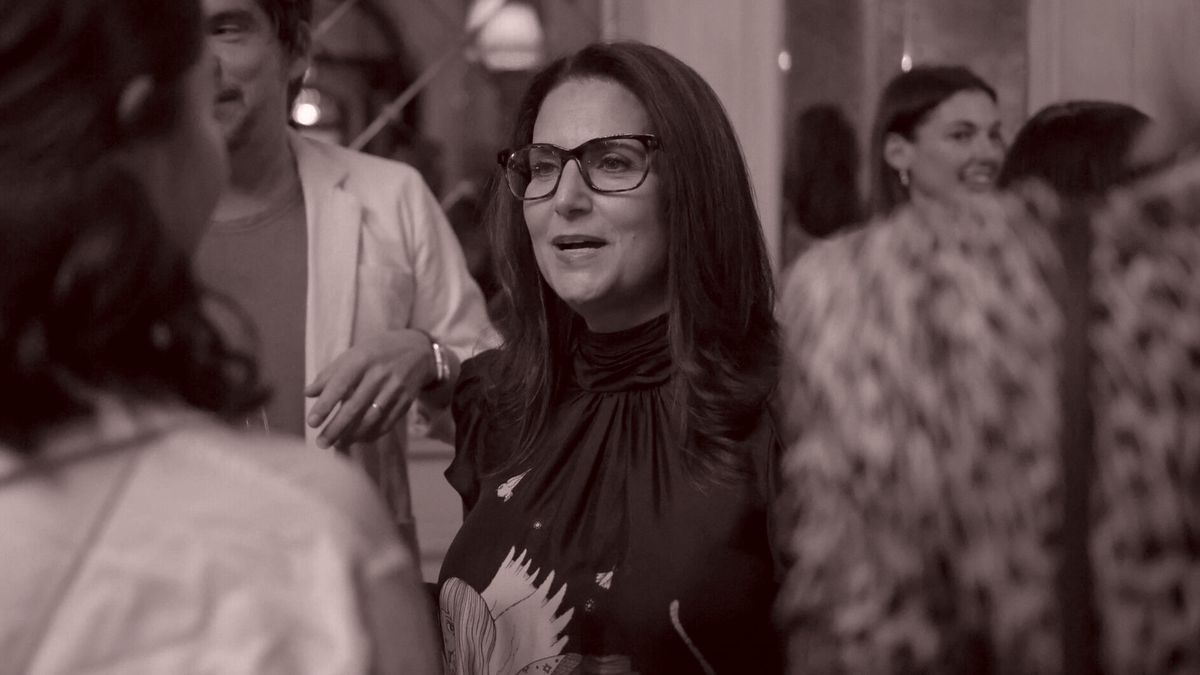Hi, and welcome back to Line Sheet. Sarah
“SShapiro@puck.news” Shapiro is back today with some chatter from the C.P.G. world, an update from the affiliate-marketing trenches, and a dispatch from your local, perfectly manicured outdoor shopping center, where there is almost undoubtedly a Madewell.
What happened to Madewell,
anyway? It was once the kinda-cool alternative to J.Crew. But instead of continuing to chase the youth, it aged up with Millennial women, who are now moms hanging out at… outdoor shopping centers. The problem for Madewell is that those shoppers have more choices now.
As you know, I’m in Europe this week. I’ll be back tomorrow with an update on the layoffs at Saks Global and the town hall that took
place today. But before heading to Milan on Wednesday night, I had some catching up to do with people in London, and missed today’s Gucci show. It was business as usual, I was told, with the requisite White Lotus stars (Parker Posey is finally getting her due), a live orchestra playing a score composed by Justin Hurwitz (of Whiplash and La La Land fame), and a collection that the press release gods called “foundational.”
Interesting that they used dark Gucci green for the catwalk rather than former designer Sabato De Sarno’s Ancora red. The collection itself was as interstitial as can be: a very Jackie Kennedy–wearing–Gucci moment. Now, we wait.
Otherwise, it’s been good to be in London for a minute. I made it to The Dover (yet another Italian-leaning, wood-paneled
establishment, this time from the former C.O.O. of Soho House) and Dover Street Market (mostly for the Phoebe Philo installation). I also stopped by the new Alaïa store—love a bookshop-in-shop. However, my most consequential shopping-related experience was walking out of the Oxford Circus tube station to buy kids’ clothes at Arket.
My first job ever and my last job before Puck had offices on Great Titchfield Street, so I’ve been exiting that station on a fairly regular basis for
more than 20 years. Until 2021, I was greeted by a block-long Topshop, where I once spent a good deal of my disposable income on acrylic jewelry, pointy flats, and going-out tops. In the city where high-low dressing was invented, Topshop brought everyone together. Now, it will soon house an Ikea, the long-term lease purchased by the Swedish furniture company for just £378 million from a bankrupt Arcadia Group after retail mogul Sir Philip Green’s cancellation. (Topshop
paid something like £500 million for the same lease.)
Anyway, it was a shock to my system, and sort of underscores the global retail crisis. London remains a great shopping city—with interesting development in tonier areas like Sloane Square and Marylebone—but that cheap-chic high-street fix is mostly found online these days. That’s why Sarah’s item today on ShopMy entering the U.K. market is so prescient.
Mentioned in this issue: Madewell, J.Crew, Gap, Mickey Drexler, Karlie Kloss, Levi’s, Paul McCartney, Somsack Sikhounmuong, Alex Mill, Libby Wadle, Abercrombie, Adrienne Lazarus, Joyce Lee, Steven Cateron, Farfetch, ShopMy, Walmart, Target, tariffs, and many more…
|
Three Things You Should Know…
|
- Lauren
on another multibrand retail mess: My former colleague Malique Morris over at BoF looked into Farfetch a year after the acquisition by Korean e-commerce giant Coupang. The gist is that Coupang’s discipline has improved the bottom line (it’s apparently profitable), and the company created a
new fee structure that offers marketplace partners more agency. On the other hand, you can see that Farfetch is becoming more of a straight-up grey market seller, along the lines of Italist and Cettire, which are very unregulated and often discount products before they are contractually allowed to by the brands. The customer service on those platforms is also terrible. (I tried to return a pair of shoes I had bought on Cettire that didn’t fit. The company claimed I had worn them, so I couldn’t
be refunded. I complained and complained but never got my money back.)
Anyway, brands are obviously wary of selling on Farfetch, and some are even going to prohibit authorized third parties from selling their stuff via the platform. That said, in the current environment, brands need more places to sell, not less. —Lauren Sherman
|
- ShopMy,
innit?: Following their successful $77.5 million Series B, ShopMy announced an expansion of their U.K. operations last week, complete with a splashy influencer dinner (of course). The move signals serious ambition in the international market, with more regional support for brand partners.
To furnish this next phase of growth, ShopMy previewed plans to add a London-based director of growth, the ability to transact in multiple currencies, and geo-links directing shoppers to regional
retailers. (Influencers with international dreams, have at it!) It remains to be seen whether their tech stack can support it all. But if so, the U.K. retail landscape will be an interesting testing ground. While Americans tend to buy head-to-toe looks and more designer clothes, Brits prefer to mix vintage, designer, and high street all in one outfit.
ShopMy will also need to navigate the U.K.’s stricter advertising regulations, and translate its commission structure profitably across
currencies and tax structures. Meanwhile, ShopMy’s platform could serve as a catalyst for U.K. brands looking to become the next Me+Em and open stores in the U.S. —Sarah Shapiro
- Big-box jitters: Last week, Walmart’s stock fell after the company announced a disappointing sales forecast of 3-4 percent growth for the year, which fell below
previous estimates. Unsurprisingly, the retailer blamed “uncertainties related to consumer behavior and global economic and geopolitical conditions” for the weak numbers. In addition to possible tariffs and continuing inflation, I’m hearing that the specter of rising unemployment, potentially including forthcoming DOGE job cuts, played a role in the revised guidance.
Walmart isn’t the only big-box retailer struggling. Target’s foot traffic has also
dropped more than 30 percent month over month, and it’s performing worse than superstores in general, according to Placer.ai. These two retail behemoths are canaries in the economic coal mine. We just saw a sharp slide in consumer
confidence, and these businesses may offer another warning about the economic landscape in 2025. —Sarah Shapiro
|
And now for the main event…
|
|
|
Madewell built their business selling mom jeans to young women. Can it sell jeans to
those same women now that they are actual moms, especially in a far more competitive retail environment?
|
|
|
No one likes to wait, particularly for a dressing room. But on a recent visit to
Madewell with my tween daughter, I was surprised (and a little delighted) to find a line outside the four dressing rooms—a sure sign that customers were finding things they at least wanted to try on. The real test, however, came in the checkout line, where we saw only one solitary shopper… with one solitary belt. Most shoppers—my daughter and myself included—left the store empty-handed.
Now approaching the tender age of 20, it seems that J.Crew’s ostensibly cooler, objectively younger sister brand is neither new nor cool. Madewell first took off in 2006 after J.Crew C.E.O. Mickey Drexler acquired the trademark—a relic of its New England workwear origins—and positioned it for style-conscious, urbane Millennial women. Back then, it occupied a valuable retail white space between work-appropriate clothing and athleisure—its denim felt premium and accessible,
a sweet spot most brands strive for, and creative professionals and young adults used its coordinated basics as wardrobe building blocks, snapping up pieces that were solidly everyday but had personality.
The brand also filled a market need at a time when Anthropologie was too magpie feminine, Gap was struggling, and Abercrombie hadn’t yet found its new glow-up. Today, Madewell has about 150 stores
across the U.S. and Canada, which, in addition to online sales, generate upward of $700 million a year in sales by our analysis. (J.Crew Group is private and shares no revenue information.)
Alas, the once-archetypal Madewell customer has grown up, found a little more disposable income, and is just as likely to be shopping for denim from Agolde, Frame, Reformation, or a revitalized Abercrombie. And Madewell never replaced that customer with a younger model. Drexler, of course, is
also long gone, and Madewell is no longer a premium denim authority nor a fashion voice for any specific demographic. As one friend recently put it, “The last time I ordered from them, I returned almost all the clothes because the quality just wasn’t there for the price.”
To be fair: Customers always complain about diminished quality when their favorite mall brand loses its cool. And other
shoppers I spoke to said that they still rely, at least in part, on Madewell’s denim; they like the handbags and belts; one person waxed poetic about the trouser socks—but the enthusiasm ended there. A few cited Quince and Everlane as lower-price alternatives for basics, Zara for more fashion-forward styles, and Alex Mill and La Ligne as preferred destinations for higher-quality striped sweaters. (Alex Mill, of course, is Drexler’s latest venture.) They also said that they can find similarly
priced dresses at Anthropologie and Hill House Home.
Madewell built their business selling no-stretch mom jeans to impressionable Millennials. Can it sell jeans to those same women now that they are actual moms, especially in a far more competitive retail
environment?
|
Since almost the beginning, Madewell has leaned on collaborations for fashion authority.
Its first partnerships were spearheaded by former Sassy and Lucky editor Gigi Guerra, who ran marketing at the company in the early 2010s. During her tenure, Guerra struck deals with companies like Barbour and even Alexa Chung, who was then in her 20s and dating an Arctic Monkey. Today, the company tends to partner with internet-y brands, including L.A.-based Donni, Lisa Says Gah, and Leset. They tried to recapture the magic with Chung again in 2024, but geriatric Millennials complained that the collection—worn by Karlie Kloss to Paul McCartney’s recent “surprise” concert in New York—didn’t compare to the original.
Early on, Madewell succeeded by betting on rigid, no-stretch styles, and its
denim authority made it one of J.Crew Group’s brightest spots amid a run of challenging years—boosting strong full-price sales while its sister brand struggled. Under C.E.O. Libby Wadle, Madewell’s revenue grew by double digits—sometimes as much as 30 percent year over year. The talent behind this success didn’t go unnoticed or unplucked: J.Crew Group promoted Madewell’s head of design, Somsack Sikhounmuong, to lead the then-struggling J.Crew brand before he
departed for Alex Mill later that same year. And after two failed C.E.O.s post-Drexler, Wadle was elevated, too. (She’s now C.E.O. of JCG.)
The financial needs of the parent company imposed other costs, too. TPG and Leonard Green & Partners took the group private in 2011 for $3 billion, saddling the company with a massive debt load that reached $1.7 billion, all of which made it harder for executives
to invest in product development. (TPG is an investor in Puck.)
There were roads not taken, too. Shortly after Drexler left in 2017, according to one source, Levi’s was interested in acquiring Madewell, but the deal fell through. Two years later, in an effort to address the J.Crew Group’s debt, a plan was hatched to take Madewell public—but by 2020, pandemic uncertainty shelved the I.P.O. and ultimately
resulted in a bankruptcy restructuring of J.Crew Group and the exit of existing investors, including TPG.
Years after Wadle took the JCG job, the company hired Adrienne Lazarus, who had most recently been involved in the troubled D.T.C. intimates brand Cuup, as co-C.E.O. so that Wadle could focus on J.Crew the brand. Lazarus quickly cleaned house at Madewell, installing an entirely new leadership team.
Creative director Joyce Lee, a 15-year veteran of the company, was replaced by Steven Cateron, who had more than a decade of experience at Club Monaco. The reshuffling has yet to redefine Madewell’s identity, which has been muffled for all the reasons mentioned above.
|
There are some signs of progress. The Spring collection, which dropped today, marks the first
full Madewell collection from Cateron. Strikingly, it refrains from desperate youth-chasing. Instead, I’d reckon that Lazarus and the team have noted the success of upper-contemporary brands like Nili Lotan, Veronica Beard, and TWP—all go-tos for wealthy moms (and non-moms alike)—and are trying to capture the customer who admires those brands but perhaps can’t afford them. A source suggested that this pivot is getting the retailer back on track, with executives touting “positive momentum” in
full-price sales, a strong indicator that the business is turning around, particularly in the critical denim category. Indeed, it’s the denim—the only hard pant that Americans wear on a regular basis—that Madewell needs to get right. The ’90s Straight (basically, better Levi’s 501s) and Perfect Vintage denim
(with a wider, but not too wide, leg) still gets praise and 5-star reviews.
|
Madewell’s 2025 Spring Collection. Photos: Courtesy of Madewell
|
Perhaps more than anything, Madewell’s identity crisis exemplifies an eternal retail truth: Brands built
on specific generational moments must evolve or risk becoming irrelevant. Under Fran Horowitz, Abercrombie has successfully pivoted to appeal to both Gen Z and Millennial mothers (and started to capture the Gen Alpha tweens too). Madewell either needs to recapture its denim authority through quality and focus or figure out how to appeal to younger buyers. If they can match their most recent, promising styling with the quality that made people love them in the
first place, they may regain their former spot in America’s closets.
|
The RealReal’s latest earnings are
officially out. A friend who frequently sources and shops from TRR speculated this week that the images on the site are starting to be A.I. generated. That’s a hot take, but not far off the truth. The company’s strategic pivot to A.I. isn’t just about pricing algorithms anymore—TRR is now betting that A.I. will fundamentally transform the consignor experience,
too. [TRR Q4 earnings]
Dries Van Noten is opening four new stores this year: New York, London, Milan, and Brussels (last two are beauty and accessories only).
[WWD]
Beyoncé’s latest Levii’s collab (a.k.a. Chapter 2) has launched—perfect timing for eager Beyhivers who need something to
wear to the Cowboy Carter Tour. The comments on Instagram are a mix of adoration and requests that the Queen Bee take a break so people’s wallets can recover. [Beyoncé]
Brooches are back after a 20-year hiatus, likely a rebellion against “quiet luxury.” (Like you, I hate that term.) Also, when the economy is weak,
customers trade in tiny wardrobe updates (see also: the lipstick effect). [WSJ]
|
Until tomorrow,
Lauren
P.S.: We are using affiliate links because we are a business. We may make a couple bucks off them.
|
|
|
Puck fashion correspondent Lauren Sherman and a rotating cast of industry insiders take you deep behind the scenes of this
multitrillion-dollar biz, from creative director switcheroos to M&A drama, D.T.C. downfalls, and magazine mishaps. Fashion People is an extension of Line Sheet, Lauren’s private email for Puck, where she tracks what’s happening beyond the press releases in fashion, beauty, and media. New episodes publish every Tuesday and Friday.
|
|
|
Puck’s daily art market email, anchored by industry expert Marion Maneker, offers unparalleled access to the mega-auctions
and galleries, elite buyers and sellers, and the power players who run this opaque world. Wall Power also features Julie Brener Davich, a veteran of Christie’s and Sotheby’s, who provides unique insights into how the business really works.
|
|
|
Need help? Review our FAQ page or contact us for assistance. For brand partnerships, email ads@puck.news.
You received this email because you signed up to receive emails from Puck, or as part of your Puck account associated with . To stop receiving this newsletter and/or manage all your email preferences, click here.
|
Puck is published by Heat Media LLC. 107 Greenwich St, New York, NY 10006
|
|
|
|














